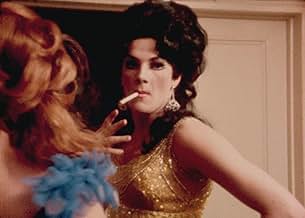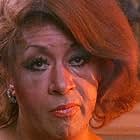The behind the scenes of a national drag queen contest in New York City, including the rehearsals leading up to the contest, the conversations in the dressing room and the jealousies that em... Read allThe behind the scenes of a national drag queen contest in New York City, including the rehearsals leading up to the contest, the conversations in the dressing room and the jealousies that emerge before and after the competition.The behind the scenes of a national drag queen contest in New York City, including the rehearsals leading up to the contest, the conversations in the dressing room and the jealousies that emerge before and after the competition.
- Self - Harlow
- (as Richard Finnochio)
Storyline
Did you know
- TriviaJack Doroshow, who portrays Flawless Sabrina, made a personal appearance some years ago at a screening of this movie which took place at the Lincoln Center for the Performing Arts Library at Lincoln Center. In addition to the film, there was some soundless film footage presented of an after party which took place immediately after the contest, that footage which may have come from the personal collection of Flawless Sabrina. This footage shows that the NYPD "raided" the after party presumably because men dressing as women in those days was still illegal. Arrogantly and with no seemingly plausible reason, the police officers walked through the party requiring numerous attendees to show their identification, such harassing actions which could have arguably led up to the Stonewall rebellion of 1969.
- Quotes
Self - Flawless Sabrina: I go up to this queen and I say, "What's your name?" The queen says, "Monique." And you say, "That's marvelous, darling, but what was your name before?" And the queen will look at you straight in the eye and say, "There was no before."
- ConnectionsFeatured in God Save the Queens (1995)
- SoundtracksDiamonds Are a Girl's Best Friend
(1949) (uncredited)
Music by Jule Styne
Lyrics by Leo Robin
Performed by Mario Montez
'The Queen' was bankrolled(?) by the late Lewis M Allen, elsewhere a Wall Street financier and Broadway producer, but you wouldn't know it from watching this movie. This is a no-budget documentary, and the cheapness and shoddiness of the production values make the subject matter look even cheaper and shoddier than necessary. I'm frankly surprised that this movie got made at ALL in the 1960s, and even more surprised that it received a general (not underground) release in 1968. Credit for the film's distribution -- spasmodic as it was -- goes to Grove Press, a publishing house notorious for issuing high-quality editions of 'Fanny Hill', 'Harriet Marwood, Governess' and other erotica of the past.
Beauty pageants in general don't much interest me, as I tend to find them demeaning ... and that goes regardless of the contenders' genders. In this movie, the sequence (sequins?) which I found most bizarre didn't involve cross-dressing at all. This was when one of the contestants, still in male attire, speaks to the interviewer in an epicene voice which falls precisely between the male and female registers. Then, suddenly, he bursts into song ... still in that same twilight register. Even more oddly, the song he's singing is 'Honey Bun', from 'South Pacific'. This is ostensibly a song performed by a macho sailor bragging about his curvaceous girlfriend, but -- as staged in 'South Pacific' -- it's actually a song written for a woman in male drag, singing about a man in female drag. I wonder if the singer in this movie intended those layers of gender-bending.
Any transvestites in the audience for this movie will probably glean some comfort from the fact that the cross-dressers shown here are (mostly) very ordinary-looking men -- overweight, balding -- with no special entree to feminine beauty nor daintiness. Any big hairy bloke who wants to look pretty has as good a chance as most of the males in this film.
For those of us not into beauty pageants, drag or otherwise, this film's major significance is historical. Among the people we see here is Richard Finnochio, now forgotten but once deeply notorious. Finnochio was the proprietor of a San Francisco nightclub which openly advertised drag acts, but which also booked stand-up comedians who were too edgy or raw to be able to get bookings elsewhere. Lenny Bruce honed his early act at Finocchio's.
Also seen here is an effeminate Latino boy named Mario Montez. I had assumed that this was a stage name, playing on MARIA Montez, a 'camp' actress who has a large gay following. I was wrong; according to the very minimal press kit for 'The Queen', that was his real name. Nice to know that something in this movie is genuine. (UPDATE: I was wrong twice; after posting this review, I received reliable information that Mario Montez was born Rene Rivera, and he did indeed name himself for Maria Motez.)
Towards the end of the film, there is some slight genuine suspense as we wait to see which of these would-be's will be crowned the queen. I shan't offer a rating for 'The Queen': it certainly does deserve one, but I'm probably not qualified to rate it objectively. Maybe this film broke some ground in 1968, but it has long since been eclipsed by far more outrageous sexual fare. Possibly that's a good thing. To anyone who thinks I disrespect the subject matter or the people depicted in this film: please note that I managed to get through this entire review without resorting to cheap wisecracks like "What a drag!"
- F Gwynplaine MacIntyre
- May 21, 2007
- Permalink
- How long is The Queen?Powered by Alexa
Details
- Release date
- Country of origin
- Language
- Also known as
- La reina
- Filming locations
- Town Hall - 123 West 43rd Street, Manhattan, New York City, New York, USA(performance venue)
- Production companies
- See more company credits at IMDbPro
Box office
- Gross US & Canada
- $47,818
- Opening weekend US & Canada
- $7,173
- Jun 30, 2019
- Gross worldwide
- $47,818
Contribute to this page



























